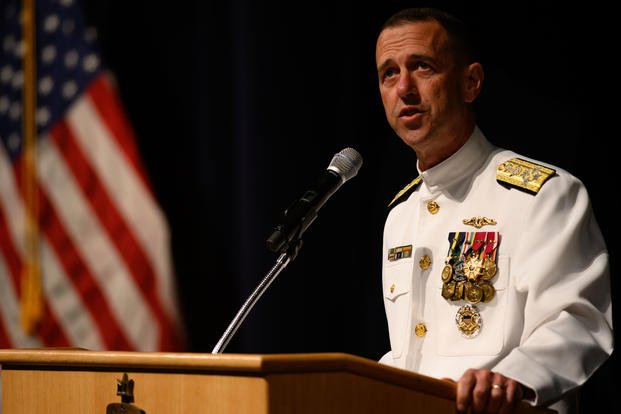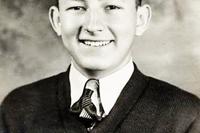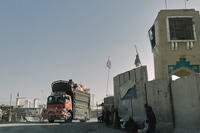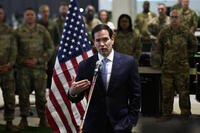This week, Adm. John Richardson will depart the role of chief of Naval Operations in much the same way he arrived: in the midst of an agenda-setting news cycle, service tumult and unresolved scandal.
The cerebral former head of Naval Nuclear Propulsion, who became the Navy's top officer in late 2015, has served through a period of service calamity and upheaval that lends itself to superlatives, beginning with an embarrassing incident in early 2016 in which 10 sailors were briefly held hostage by Iran and including, most notably, a pair of deadly ship collisions that claimed the lives of 17 enlisted men.
As Richardson prepares to hand off authority to his successor, Joint Staff Director Vice Adm. Michael Gilday, the Navy remains haunted by the aftermath of the collisions and the still-ongoing Glenn Defense Marine Asia "Fat Leonard" corruption scandal, now nearly a decade old. Both events have contributed to a Navy in which untarnished senior leaders are in short supply and in which strategy has sometimes appeared to take a backseat to crisis response.
Recent events -- including a massive review of the Navy's legal system that comes after officers including Richardson were faulted for improper behavior, a major SEAL misbehavior scandal and a last-minute decision to send Adm. Bill Moran, a seasoned and deeply respected admiral, to retirement rather than to the position of CNO -- promise to dog the Navy well into the future.
For Richardson, the question remaining is one of legacy: Will he be remembered as the admiral who pushed the Navy into broader discussions of great power competition and broader fleet capacity, or the officer who presided over some of the service's greatest preventable tragedies? And, despite sweeping accountability measures that prompted some to ask whether Richardson himself deserved to keep his post as CNO, uncertainty remains as to whether the Navy has done enough to right itself in the wake of the disasters.

Great Power
According to multiple former staff members who spoke to Military.com on background, Richardson arrived at his post in 2015 with something of an outsider's mentality. Though he and his predecessor, Adm. Jon Greenert, both hailed from the submarine community, he was the first Navy head of nukes to be CNO. And, sources say, his way of doing the job was sometimes seen as unconventional. He had a number of civilians on his staff, for example, and though he had a glittering resume that included the Navy's prestigious Stockdale Award for inspirational leadership, he did not always fall in with Pentagon business as usual.
"He is a nuke," said a former staff member, who asked not to be identified, referring to Richardson's background in the demanding, precise field of naval reactors. "So the way I used to describe it to people is, do not go into his office and have a conversation about the forest. He's pretty quickly going to be asking you about trees. And if you don't show that you have command of the trees, you're going to be in trouble."
No news, Richardson would say, according to the staffer, was not good news.
At the same time, former staff members said, Richardson was eager to advance a vision for the Navy that emphasized great power competition; the rise of near-peer competitors including Russia and China; and the need for an increasingly joint operating environment to maintain dominance on a global stage.
His earliest public speeches as CNO addressed the "four-plus-one" framework of global competitors that also included Iran, North Korea and international terrorism. And in January 2016, he released a first version of his "Design for Maintaining Maritime Superiority:" a document meant to strengthen the Navy -- as much through individual sailor character development and toughness as through organizational stability and adaptiveness -- for the challenges of the future.
In some ways, Richardson's rhetoric was a preamble for that of future Defense Secretary Jim Mattis, his former boss at the now-disestablished U.S. Joint Forces Command. Mattis led the Norfolk-based command from 2007 to 2010, overlapping with then-Rear Adm. Richardson, who served as its director of strategy and policy.
"The way he thought about [the strategic environment] was the way Jim Mattis fell in on it, almost word for word, two years later," a former Richardson staffer said. "I hope he gets credit for not only reorienting the Navy, but he hugely informed Mattis' thinking. That, I think, is wildly underappreciated."
Push for 355
Under Richardson, a longtime generalized push for a bigger fleet became a strategy to reach a specific number: 355 ships, an increase of more than six dozen from the 2016 fleet of 279. That number, with the full-throated support of the Trump administration, became a rallying cry on Capitol Hill and the subject of countless cost assessments, planning documents and think pieces.
The number continues to dominate headlines, although Richardson himself has walked back the figure on multiple occasions, saying his concern is more about the capability of the Navy than the number of hulls.
"I think Adm. Richardson was always wary of reducing the Navy to a ship count. He always stood by 355, but he also always emphasized that the top priority had to be the overall naval capability," said Chris Brose, former staff director at the Senate Armed Services Committee, a position he held from 2015 to 2018. "I think his concern was that the 355-ship Navy was the answer to old questions. I think his vision of the future Navy was more unmanned systems, which could make it both more capable and possibly a lot larger than 355 ships."
The figure did help develop a fleet-shaping strategy featuring the inclusion of large unmanned surface vessels and make a case for a robust ship-building budget. But it didn't troubleshoot the Navy's entrenched readiness issues. A recent Navy mid-year budget review found the service faces nearly $1 billion in unfunded maintenance for 2020, and is short in the hundreds of millions for ship repair this year, according to a Defense News report.
"I think for Adm. Richardson, and for a lot of people, they're realizing how holistically inept that [355] number is in terms of talking about the capability and the health of the Navy," said another former Richardson staff member who spoke with Military.com. "Are the ships in good shape, are the sailors trained ... there are so many other things you should really look at."
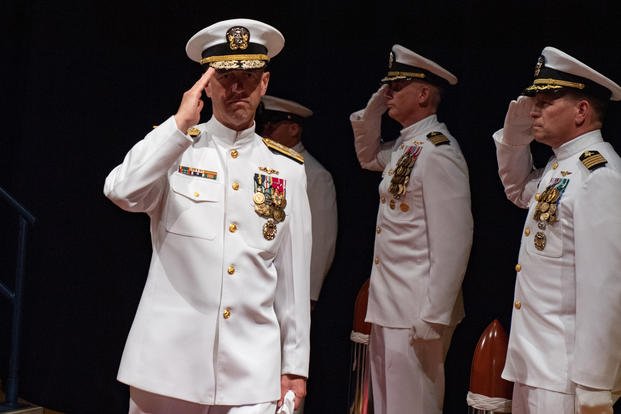
Crisis Management
Coming into the job, Richardson was no stranger to crisis management, having been head of the Navy's nuclear program during a 2014 cheating scandal that saw the expulsion and punishment of some three dozen senior enlisted sailors at the Naval Nuclear Power School.
The first major test as CNO would come when, through a series of errors, two Navy riverine boats would end up in Iranian waters in January 2016, resulting in a 24-hour hostage crisis requiring intervention from the State Department. Richardson's very first media briefing at the Pentagon as head of the Navy in June 2016 would be focused on the riverine investigation, which revealed training and continuity shortfalls and resulted in a handful of officer reliefs and more administrative punishments.
Of the challenges and crises large and small that followed, some were inherited, others seemingly more preventable.
"Adm. Richardson came in with a very thoughtful and aggressive set of priorities and lines of effort he wanted to go after," a former staff member said. "It became very clear from him and the staff that just the day-to-day and the current environmental impacts on the Navy were going to take a lot of his time and make it harder to get that aggressive agenda done."
Richardson inherited the cost overruns and technology overreach of the new Ford class of carriers. On his watch, the first of three supercarriers was delivered to the Navy, though criticism over technology delays and non-working weapons elevators continues.
He also inherited the disastrously far-reaching "Fat Leonard" scandal that, during his tenure, saw a head of Naval intelligence, Vice Adm. Ted "Twig" Branch, stripped of his security clearance, and many more officers stuck in holding patterns amid related misconduct investigations. To date, seven admirals and two captains have been disciplined or chastened by the Navy, some 16 Navy officers have pleaded guilty to various criminal charges, and roughly a dozen more await trial, according to Washington Post reporting.
Other scandals hit closer to home. In 2017, USA Today broke news that Richardson had kept on a spokesman, Cmdr. Chris Servello, for months after allegations surfaced that Servello had behaved inappropriately, making unwanted advances at women while dressed as Santa during a 2016 holiday party at the Pentagon. A report from the Pentagon Inspector General's office, made public in late 2018, faulted Richardson for not acting fast enough to address the allegations and reassign Servello, although it stopped short of substantiating misconduct on the part of the CNO.
No criminal charges were ultimately recommended against Servello. But the issue was hot enough that the Navy's first pick to replace Richardson, Adm. Bill Moran, was abruptly ousted from succession and pushed toward retirement by Navy Secretary Richard V. Spencer earlier this year amid an investigation into emails Moran had exchanged with Servello seeking professional advice.
When, in spring 2018, allegations surfaced of workplace misconduct perpetrated by Richardson's senior enlisted adviser, Master Chief Petty Officer Steven Giordano, the CNO moved quickly, taking the rare step of accepting a MCPON's resignation.
"I appreciate [Giordano's] recognition that the situation had become untenable," Richardson wrote in a June 21, 2018, statement.
An investigation would later find Giordano had bullied staff, sent enlisted sailors to fetch food and coffee for him and otherwise created an unfavorable work environment.
Deadly Collisions
In the wake of the two horrific destroyer collisions -- in June and August 2017 -- individual accountability was also firmly in focus.
The commanders and executive officers of both ships were rapidly relieved of their posts. So was Vice Adm. Joseph Aucoin, then head of the U.S. 7th Fleet in the Pacific, where both collisions occurred. Vice Adm. Phillip Sawyer, Aucoin's replacement in the 7th Fleet, would go on to remove Rear Adm. Charles Williams, commander of Combined Task Force 70, which oversaw the destroyers Fitzgerald and John S. McCain, and Capt. Jeffrey Bennett, commodore of Destroyer Squadron 15, to which the two ships belonged.
The head of Naval Surface Forces, Vice Adm. Thomas Rowden, was also recommended for retirement as a result of the collisions. And, in September 2017, Adm. Scott Swift, the four-star head of U.S. Pacific Fleet, announced that he'd been informed he was not Richardson's choice to head U.S. Pacific Command, as had been widely expected, and would instead request retirement.
"There were two- and three-star heads all over the place," Brose said. "And it was not as if the Navy had a lot of flag officers to spare. That sent a clear message that there would be accountability, and I think the contrast with how some of the other services responded to their own mishaps was striking."
In addition to incident investigations that faulted the poor decisions of ship leaders and crew and a pair of wide-ranging reviews that described systemic problems including an overtaxed and undertrained fleet, a National Transportation Safety Board report on the McCain collision released just this month pointed to crew fatigue as a major factor in that disaster. And a months-long ProPublica investigation released earlier this year described years of warning signs and indicators that all was not well in the Pacific Fleet, and how the Navy was routinely assuming risk and sending out unready ships in order to meet its mission objectives.
Some wondered whether accountability measures should have extended to the CNO himself.
"What responsibility, as CNO, do you bear on this?" CNN correspondent Barbara Starr asked Richardson in November 2017, when he appeared in the Pentagon briefing room to discuss the results of a fast-tracked comprehensive review into the causes of the collisions. "With all due respect, do you believe that you still have the confidence of the sailors and the Navy families?"
"I feel responsible for this," Richardson responded, but added that he believed he still had the confidence of the fleet to remain in his position.
In fact, according to former staff of Arizona Sen. John McCain, the late former head of the Senate Armed Services Committee, and staff of McCain's successor in the role, Oklahoma Sen. Jim Inhofe, there was never a push from them to oust Richardson. He delivered accountability in spades, and that was reassuring.
"McCain was pleased that the CNO was delivering accountability," Brose said. "He would have been the first to call for the CNO's ouster if he thought it warranted. He never did."
While the Navy ended senior officers' careers and publicly acknowledged major shortfalls in training, readiness and maintenance leading up to the collisions, the Army, for example, weathered a fiasco mission in Niger that left four soldiers dead with little in the way of public accountability.
Richardson likely also benefited from a confluence of factors including leadership transition and timing: Navy Secretary Ray Mabus retired after an eight-year term at the start of the Trump administration in January 2017, and was not succeeded by a confirmed SecNav, Richard V. Spencer, until August of the same year, just weeks before the John S. McCain collision. Likewise, Defense Secretary Jim Mattis was new on the job in January 2017 and served just two years, departing abruptly in December 2018 after citing differences with the administration.
"Any time you get rid of a service chief, it causes perturbation and ripples up and down the organization," a former Richardson staff member said. "My sense is, [the military chain of command] looked at the issues [and their handling]."
The Navy had seen its most senior leaders removed amid scandal in the not-so-distant past. CNO Adm. Frank Kelso retired early and Navy Secretary Lawrence Garrett resigned in the wake of sexual harassment and assault at the 1991 Tailhook Association annual convention for naval aviators. While many officers were disciplined and demoted, none were court-martialed, and some in Congress believed the Navy hadn't done enough to hold perpetrators accountable.
It does send a message when accountability goes all the way to the top, however.
"I do know that, from talking to my contemporaries, it's a real head-scratcher for them," the former staff member said, describing the Richardson era and his continuing to serve following the collisions and "Bad Santa" debacle. "It's pretty easy to lose confidence at the O-5 and O-6-level, but not so much at the four-star level. I think it leads into some cynicism. I think it leads into some of those leaders deciding that they don't want to stick around."
Lasting Changes
On the other hand, there are those who ask whether accountability measures went too far, at the expense of real and lasting change for the Navy based on shortfalls and gaps the collisions revealed. Swift, the former PACFLEET commander, announced his request to retire gracefully, saying he would continue to serve with "the energy of an ensign" until the Navy determined his service end date. At his retirement in May 2018, he urged that readiness accounts be fully funded to prevent future tragedy.
"I still worry that there's no real constituency for readiness ... it's an age-old problem," Swift told Military.com in a recent interview. "In my 40 years in the Navy, readiness had traditionally been a bill-payer that's available for the Navy to pay other things."
Swift added that he is concerned the Navy is pushing aggressively for fleet growth despite indicators that the industrial base is challenged to provide adequate support to the current fleet.
At the same time, he asked whether there is an overemphasis on ending careers and doling out punishments after the ship disasters -- accountability actions that included the extremely rare step of sending some crew members to court-martial on negligence-related charges. Swift also expressed dismay at Moran's being pushed toward retirement, rather than being supported for CNO, and asked if the Navy had gone too far in arresting the careers of officers even tangentially connected to the Fat Leonard scandal.
Vice Adm. Michael Gilday, set to replace Richardson on Thursday, was the first three-star admiral to be nominated for CNO since 1970 amid thinned senior leadership ranks.
"This assumption of guilt and wrongdoing has been hurtful, back to this culture of operational excellence," Swift said. "When we have failures in character, in leadership, we should act quickly. When we have failures in judgment, maybe we should take a different approach with that."
Moving Forward
The final chapter has yet to be written on the Navy's response to the ship collisions. In one of his last acts as CNO, Richardson announced a wide-ranging review of the Navy JAG Corps, from training to organization and performance -- a move motivated by recent high-profile prosecution missteps in a number of cases, but also in part by a finding that Richardson and Moran, then vice CNO, had both committed apparent unlawful command influence by discussing the negligence of crew members before prosecutions were complete.
Gilday and other Navy leaders will have ample opportunity to look for balance between institutional change and accountability measures elsewhere as well: In recent weeks, a Navy SEAL team's deployment was cut short amid allegations of widespread misbehavior, prompting an ethics review and likely a community-wide reckoning on standards and professionalism.
Swift recommended that Gilday take to heart the clear-eyed strategic guidance published last month by the Marines' new commandant, Gen. David Berger. In the document, Berger voices a willingness to sacrifice force structure and break with past conceptions of service requirements and operating protocol in order to fund modernization and meet future needs.
With fresh eyes and a degree of removal, having not been directly involved in the collisions' aftermath, Gilday has the opportunity to make investments that will help re-establish a culture of excellence, he said.
"Certainly, the track record of the Navy has been a challenging one over the last two, three, four years," Swift said. "... It seems that the tenure of CNO Richardson has been fraught with crisis after crisis."
Richardson's own legacy will likely remain the subject of debate. The CNO's office acknowledged questions and requests for comment, but did not provide answers or a statement by press time. The SecNav hailed Richardson's service in a statement.
"The Sailors serving this nation are constantly on Adm. Richardson's mind and close to his heart. As much as Adm. Richardson has done for our capabilities and processes, he's done more for our people. Thanks to his efforts, the men and women of the U.S. Navy are safer, better prepared, and better commanded while standing watch around the world," Spencer said. "Adm. Gilday has already played a critical role in restoring our readiness and lethality, and he's well positioned to help take our integrated naval force into the next decade."
A former U.S. official who worked closely with the Navy for much of Richardson's time as CNO described him as an exceptional officer who was forced to contend with many problems not of his own creation.
"I think the tragedy of Adm. Richardson's tenure is that one of the Navy's most strategic, thoughtful and visionary leaders had to spend so much of his time cleaning up the mess that resulted from years and years of dishonest and bad decision-making, both in the Navy and Congress," the official said. "Many of the problems that he got saddled with were a long time in the making. He just got handed the baton when the team was unfortunately pretty far behind in the race."
-- Hope Hodge Seck can be reached at hope.seck@military.com. Follow her on Twitter at @HopeSeck.
